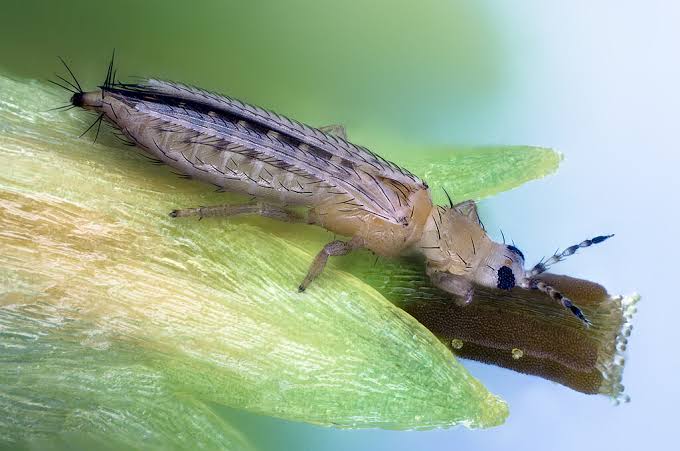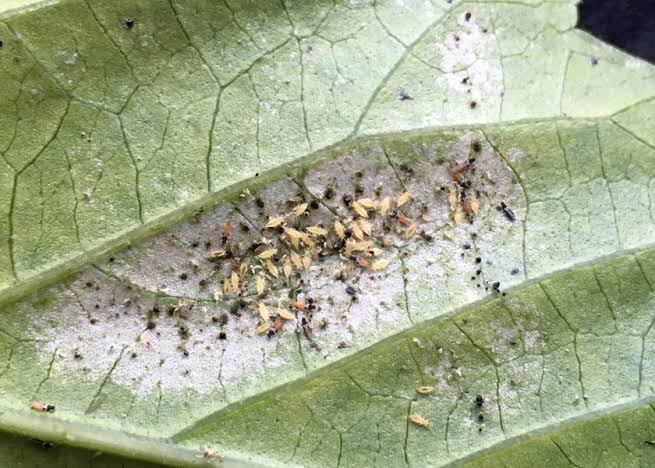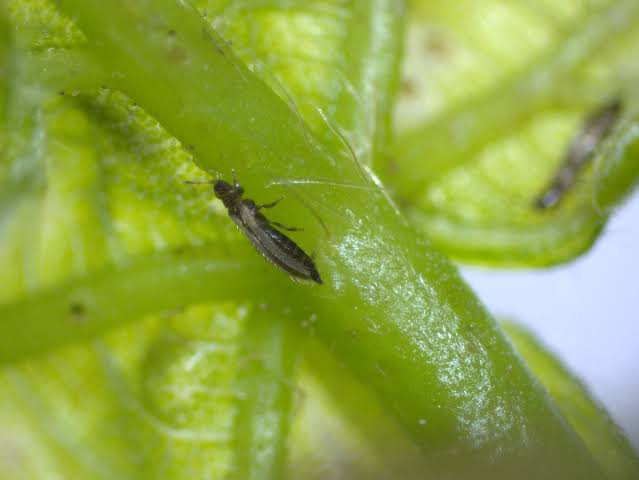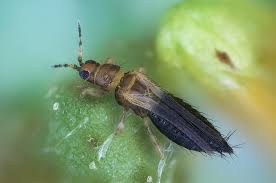Thrips, scientifically known as Thysanoptera, are minuscule insects that play a significant role in various ecosystems. Despite their small size, these creatures wield influence in agriculture, horticulture, and the natural world.
These minute insects measure only a few millimeters in length, making them challenging to spot with the naked eye. Their slender bodies, fringed wings, and unique rasping-sucking mouthparts set them apart in the insect kingdom. Thrips thrive in diverse environments, from lush gardens to agricultural fields, showcasing their adaptability.
One remarkable aspect of thrips is their feeding behavior. These insects feed on plant tissues by puncturing and sucking the cell contents, leaving behind distinctive scars. While some thrips are considered pests due to the damage they inflict on crops, others contribute to pollination by transferring pollen between plants.
In agriculture, thrips can pose a double-edged sword. On one hand, they can damage crops by feeding on plant sap and transmitting plant diseases. On the other hand, certain species of thrips are employed as biological control agents to manage pest populations, showcasing their potential as allies in pest management strategies.
Thrips also exhibit intriguing life cycles. They undergo incomplete metamorphosis, progressing through egg, nymph, and adult stages. This relatively simple life cycle allows them to reproduce rapidly under favorable conditions, posing challenges for farmers and gardeners alike.
Beyond their impact on agriculture, thrips contribute to the broader ecosystem. Their role in pollination, albeit modest compared to bees and butterflies, aids in the reproduction of various plant species. Additionally, thrips serve as a vital food source for many predators, further highlighting their ecological importance.
Despite their small size, thrips continue to captivate researchers and entomologists. Ongoing studies seek to unravel the intricacies of thrips behavior, biology, and their role in maintaining ecological balance.
However, thrips may be diminutive in size, but their presence resonates across ecosystems. From agricultural fields to gardens, these tiny insects leave an indelible mark on the world around us, showcasing the interconnectedness of all living organisms in the intricate tapestry of nature.
Read Also: Persimmons: History, Nutrition, Health Benefits and Growing Guide
Plants Affected by Thrips (Thysanoptera)

Thrips can affect a wide variety of plants, causing damage through their feeding habits. These tiny insects pierce plant tissues and extract cell contents, leading to a range of symptoms. Some plants commonly affected by thrips include ornamental flowers, vegetables, and fruit crops.
Ornamental flowers, such as roses, chrysanthemums, and dahlias, are often targets for thrips. The feeding damage can result in distorted or discolored petals, reducing the aesthetic appeal of these plants. Additionally, thrips may leave behind silvering or stippling on the leaves, further impacting the overall health and appearance of ornamental flowers.
Vegetable crops, including tomatoes, peppers, and onions, can also fall victim to thrips infestations. Thrips feeding on these plants may cause distorted growth, stippling on leaves, and in severe cases, the transmission of plant viruses. The damage to vegetable crops can compromise both quality and yield, posing challenges for farmers and gardeners.
Fruit crops, such as strawberries, citrus fruits, and grapes, are not immune to thrips damage. Thrips feeding on developing fruits can lead to scars, deformities, and reduced fruit quality. In some instances, the transmission of plant diseases by thrips can further jeopardize the productivity of fruit-bearing plants.
It is essential for growers and gardeners to monitor plants for signs of thrips infestations and implement appropriate control measures. Integrated pest management strategies, including the use of beneficial insects, insecticidal soaps, and cultural practices, can help mitigate the impact of thrips on various plant species. Understanding the specific vulnerabilities of different plants to thrips is crucial for effective pest management in agricultural and horticultural settings.
Moreover, thrips can extend their impact to greenhouse crops, affecting a range of cultivated plants grown under controlled conditions. Greenhouse environments provide favorable conditions for thrips infestations due to the relatively stable temperatures and high humidity.
Within greenhouses, ornamental crops like begonias, ferns, and orchids can suffer from thrips damage. The consequences often include distorted growth, reduced flower quality, and aesthetic impairment. Thrips can be particularly challenging in greenhouse settings, requiring vigilant monitoring and proactive pest management strategies.
In agricultural landscapes, field crops such as cotton, soybeans, and peanuts may face thrips-related challenges. Thrips feeding on these crops can lead to reduced yields and impact the quality of harvested products. Farmers often need to balance the use of chemical controls with other sustainable practices to manage thrips and minimize the associated economic losses.
Furthermore, the presence of thrips can exacerbate challenges for plants already facing stress factors such as drought or nutrient deficiencies. Stressed plants are often more susceptible to thrips damage, creating a compounding effect that can escalate pest-related issues in agricultural and horticultural settings.
As researchers delve deeper into the interactions between thrips and various plant species, there is an increasing emphasis on developing integrated and sustainable approaches to manage thrips populations. This includes exploring biological control methods, optimizing cultural practices, and developing resistant plant varieties to mitigate the impact of thrips on diverse crops.
Thrips exhibit a broad host range, affecting ornamental flowers, vegetable crops, fruit-bearing plants, and even greenhouse cultivars. Understanding the specific vulnerabilities of different plant species to thrips is crucial for implementing effective pest management strategies and safeguarding agricultural and horticultural productivity.
Damages Caused by Thrips

Thrips can inflict various damages on plants, affecting their overall health and productivity. The consequences of thrips infestations manifest through distinct symptoms that vary depending on the plant species and the severity of the attack.
1. Feeding Damage: Thrips feed by puncturing plant tissues and extracting cell contents, leading to visible damage. This feeding activity often results in stippling, silvering, or bronzing of the affected plant parts. Leaves may exhibit tiny scars, and in severe cases, plants may experience wilting or distortion.
2. Deformed Flowers and Fruits: Ornamental plants and fruit-bearing crops can suffer from deformed flowers and fruits due to thrips feeding on developing tissues. The damage may lead to malformed or stunted growth, reducing the aesthetic appeal of flowers and the market value of fruits.
3. Transmission of Plant Diseases: Thrips can act as vectors for plant viruses, transmitting pathogens from plant to plant as they feed. This introduces an additional layer of damage, as infected plants may exhibit symptoms such as yellowing, mosaic patterns, and stunted growth. The spread of diseases through thrips can have significant implications for agricultural and horticultural crops.
4. Impact on Photosynthesis: The feeding activity of thrips can disrupt the normal functioning of plant cells, affecting photosynthesis. Reduced chlorophyll content and altered leaf structure can diminish the plant’s ability to capture sunlight and convert it into energy. This can lead to a decline in overall plant vigor and productivity.
5. Secondary Infections: Thrips-induced wounds can create entry points for secondary infections by bacteria or fungi. These opportunistic pathogens may further compromise plant health, leading to the development of lesions, cankers, or necrosis. The combination of thrips feeding and secondary infections can escalate the overall damage.
6. Economic Impact: In agricultural settings, the economic impact of thrips extends beyond direct plant damage. Reduced yields, lower product quality, and the need for additional pest management measures contribute to increased production costs for farmers. Addressing thrips-related issues becomes crucial for sustaining profitable agriculture.
Understanding the diverse ways in which thrips can cause damage is essential for implementing effective pest management strategies. Integrated approaches that combine cultural practices, biological controls, and targeted insecticides play a pivotal role in mitigating the impact of thrips on plants and ensuring the overall health of agricultural and horticultural ecosystems.
Read Also: Sapotes: History, Nutrition, Health Benefits and Growing Guide
Control and Preventive Measures

Implementing effective control and preventive measures is crucial to managing thrips infestations and minimizing their impact on plants. A comprehensive approach that combines cultural, biological, and chemical strategies can provide a balanced and sustainable solution.
1. Cultural Practices:
Remove Weeds: Thrips often thrive on weeds, so keeping the area around plants free of weeds can help reduce their habitat.
Pruning: Regularly prune and remove infested plant parts to eliminate thrips and prevent further spread.
Crop Rotation: Rotate crops to disrupt thrips’ life cycle and reduce the risk of continuous infestations.
2. Biological Control:
Predatory Insects: Introduce or encourage natural predators of thrips, such as predatory mites, ladybugs, and minute pirate bugs, to keep thrips populations in check.
Parasitic Wasps: Some parasitic wasps lay eggs inside thrips, controlling their populations. Encourage the presence of these beneficial wasps in the environment.
3. Exclusion Techniques:
Row Covers: Use row covers to physically exclude thrips from reaching vulnerable plants, especially in greenhouse or high-value crop settings.
Screening: Install screens or meshes to prevent thrips entry into greenhouses or enclosed spaces.
4. Monitoring and Early Detection:
Sticky Traps: Deploy yellow or blue sticky traps to monitor thrips populations. Regularly inspect traps for early detection and assessment of infestation levels.
Visual Inspection: Conduct regular visual inspections of plants, focusing on the undersides of leaves where thrips often congregate.
5. Insecticidal Soaps and Oils:
Soap Sprays: Insecticidal soaps disrupt thrips’ cell membranes, providing an effective and environmentally friendly control method.
Neem Oil: Neem oil has insecticidal properties and can be used to control thrips. It also acts as a repellent and disrupts the insect’s life cycle.
6. Chemical Insecticides:
Selective Insecticides: If chemical control is necessary, use selective insecticides that target thrips while minimizing harm to beneficial insects.
Rotate Insecticides: Rotate between different classes of insecticides to reduce the risk of thrips developing resistance.
7. Resistant Varieties:
Select Resistant Plants: When possible, choose plant varieties that are less susceptible to thrips damage. Some plant species and cultivars exhibit natural resistance.
8. Integrated Pest Management (IPM):
Holistic Approach: Adopt an integrated pest management approach that combines various strategies, considering the ecological balance and long-term sustainability.
By integrating these measures into a comprehensive pest management plan, growers and gardeners can effectively control thrips infestations, minimize plant damage, and promote the overall health of their crops. Regular monitoring and timely intervention are key components of successful thrips management strategies.
Frequently Asked Questions (FAQs) About Thrips (Thysanoptera)
Q1: What are thrips?
A1: Thrips are tiny insects belonging to the order Thysanoptera. They have slender bodies, fringed wings, and rasping-sucking mouthparts.
Q2: What do thrips feed on?
A2: Thrips feed on plant tissues by puncturing and sucking cell contents. Some species are considered pests as they damage crops, while others play a role in pollination.
Q3: How do thrips affect plants?
A3: Thrips can cause damage to plants by feeding on them, leading to symptoms such as stippling, silvering, distorted growth, and, in severe cases, transmission of plant diseases.
Q4: Which plants are commonly affected by thrips?
A4: Thrips can affect a wide range of plants, including ornamental flowers (roses, chrysanthemums), vegetables (tomatoes, peppers), fruit crops (strawberries, citrus), and greenhouse cultivars.
Q5: How can I identify thrips infestations?
A5: Look for signs such as stippling, silvering, distorted growth, and scars on plant tissues. Sticky traps and visual inspections, especially on the undersides of leaves, can help in early detection.
Q6: Are thrips harmful to humans or animals?
A6: Thrips are primarily plant feeders and are not known to be harmful to humans or animals. They do not bite or transmit diseases to humans.
Q7: What are some natural predators of thrips?
A7: Predatory mites, ladybugs, minute pirate bugs, and certain parasitic wasps are natural enemies of thrips. Encouraging these predators can help control thrips populations.
Q8: How can I control thrips without using chemical insecticides?
A8: Cultural practices like pruning and removing infested plant parts, introducing predatory insects, using sticky traps, and employing insecticidal soaps or neem oil are eco-friendly ways to control thrips.
Q9: Can thrips be controlled in greenhouses?
A9: Yes, thrips can be controlled in greenhouses using exclusion techniques like row covers, screening, and the introduction of natural predators. Monitoring and early detection are crucial in enclosed environments.
Q10: Are there plant varieties resistant to thrips?
A10: Yes, some plant varieties show natural resistance to thrips. When possible, selecting resistant plants can be an effective preventive measure.
These FAQs provide a basic understanding of thrips, their effects on plants, and various control measures. For specific concerns, it is advisable to consult with local agricultural extension services or pest management experts.
Read Also: Potato Farming Guide – 7 Tips to Grow Sacks Full of Potatoes

